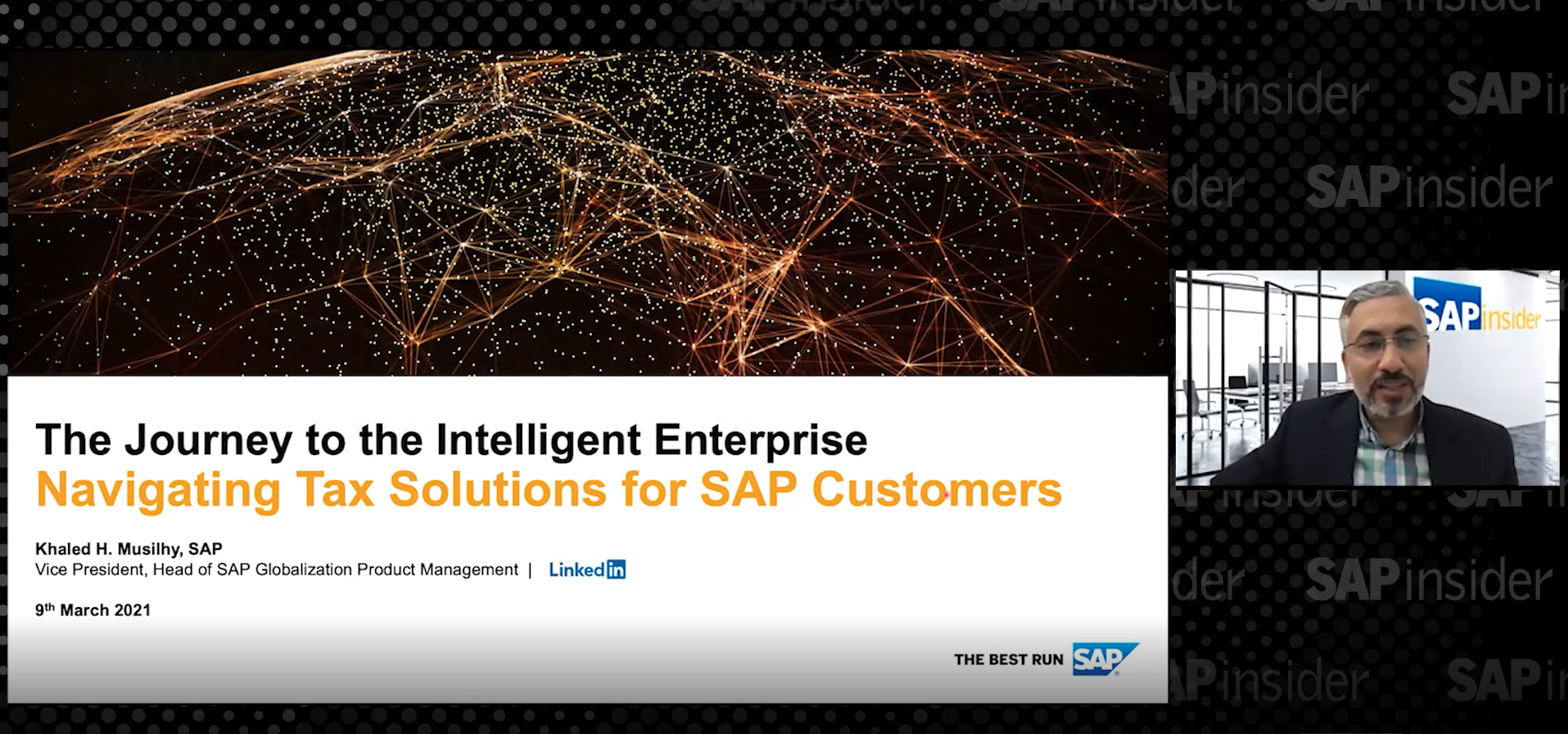Tax Compliance at the Edge with ONESOURCE
Meet the Authors
Key Takeaways
⇨ Edge computing facilitates faster tax determination
⇨ Edge computing allows organizations to process tax information as close to the transaction as possible
⇨ Customers can integrate its comprehensive suite of tax and legal risk content across all tax types
Using Edge Computing to Enable Tax Compliance
As the world becomes more interconnected and the complexity of indirect tax regulations continues to grow, multinational organizations need to centralize their business and financial data to ensure a single source of truth. SAP S/4HANA is a robust offering for achieving this goal, but using it alone can present challenges like latency and an increased load on the central system. Recent SAPinsider research highlights e-invoicing, VAT/GST, and sales and use tax as the most problematic regulatory updates for tax teams. Thomson Reuters and SAP have a long-standing history of collaboration and co-innovation to enable quick delivery of solutions capable of solving massive tax compliance ROI challenges for SAP organizations.
In a recent interview with Vice President of Product Management Ray Grove and Vice President of Partnerships & Alliances Kelley Lear from Thomson Reuters, they shed light on how organizations are integrating, a unified global tax engine, such as ONESOURCE, with their SAP landscapes to ensure tax compliance and maximize value on cloud deployments.
Explore related questions
“Our SAP relationship allows Thomson Reuters to holistically partner with SAP, across our direct and indirect tax offerings. The Global Minimum Tax and Superfund Excise Tax provide great examples of our ability to come to market quickly with our solutions and solve massive ROI challenges customers face regarding tax compliance” says Lear.
ONESOURCE and SAP S/4HANA: A Unified Solution for Complex Tax Compliance
Thomson Reuters recently announced that ONESOURCE Indirect Tax has achieved SAP technical certification for integration with SAP S/4HANA Cloud, private edition. This certification enables customers to use the ONESOURCE Determination product to perform accurate tax calculations, simplify technical requirements, and maintain compliance with evolving tax regulations while reducing the need for customizations.
With companies continuing their move to the cloud, specifically SAP S/4HANA Cloud, Thomson Reuters offers customers a unique competitive advantage with an SAP-certified tax solution globally and maintains SAP Certification for the tax service integration with RISE with SAP S/4HANA Private Cloud. Cloud deployments enable continuous updates while addressing critical needs in localization and content management. The ONESOURCE integration for SAP S/4HANA Cloud offers support for more than 205 countries and territories, including support for the standard SAP interface for U.S. sales and use tax.
Grove explains why SAP organizations should consider a “true cloud native architecture” to fully leverage the benefits of SAP S/4HANA and indirect tax compliance. “It is no longer acceptable for businesses to suffer downtime for content updates, feature updates, or security patches. A true cloud infrastructure should support auto-scaling, auto-provisioning, and other essential functions that provide a reliable and fast service. This is particularly important in the case of indirect tax, as businesses often experience peak periods and need real-time tax information.”
For organizations aiming to get the most out of their investments in SAP S/4HANA, a strong cloud infrastructure is just the beginning. To truly maximize that investment, edge computing technology may offer added benefits for businesses with certain requirements.
The Importance of a True Cloud Architecture with Edge Computing
As transaction volumes and complexity increase, organizations running complex financial systems must calculate accurate tax details for transactions at the point of sale, whether online or in physical retail locations. The shift to cloud-based infrastructure, while beneficial in terms of cost, ease of management, scalability, and reduced administrative overhead, has also introduced challenges related to performance and usability. That’s where extending cloud computing with edge computing alongside centralization can help to maintain high performance and manage complexity. By processing and analyzing data at the network’s edge close to the source, businesses can:
- Support real-time applications
- Improve responsiveness
- Improve the accuracy and speed of tax calculations
- Reduce the compliance burden
- Avoid the risk of non-compliance
Edge computing technology allows SAP organizations with existing on-premise systems to obtain cloud benefits. Which means it could also be a stepping stone for those going from on-premises to cloud. This represents a critical consideration for organizations evaluating their future SAP landscape in the context of competing in a digital economy.
Investing in Industry-Focused Tax Compliance
The rapid digitalization of businesses has led to a swift evolution of tax regulations across every industry, further accelerated by the effects of the COVID-19 pandemic. Organizations operating diverse businesses must now keep pace with these fluctuating tax mandates while maintaining compliance. Thomson Reuters recognizes this challenge and has strategically invested in industry-specific solutions to assist companies in navigating these complex tax situations.
Lear explained, “We recognize the complexity of certain industries, recently obtaining our chemical industry certification for industry cloud through SAP. They consider us the primary provider for chemicals since we were first to market with the Superfund Excise Tax solution. Additionally, we continue to invest in the oil and gas sector, encompassing upstream, midstream, and downstream capabilities.
“It’s a massive area, significantly affected by the Superfund Tax and the economic climate over the past couple of years, so we’re heavily investing there. Traditionally, Thomson Reuters has also served a robust manufacturing base, one of our largest sectors. The retail industry, a substantial area where edge computing solutions are particularly beneficial, is another market with some of the largest ecommerce companies using ONESOURCE today.”
Retail Industry: The Omnichannel Challenge
The retail industry has become increasingly omnichannel, with businesses operating through various digital and physical channels. Many retail stores already leverage edge computing to enhance the customer experience with real-time data analytics, facial recognition, and customer tracking.
“Every large business is an omnichannel business at this point; whether it is physical locations in regions, channels that are digital, or channels that are hybrid, digital, and physical.
“There is a popular sports memorabilia company that is a customer of ours. They have a website. They’re at ballparks. They have physical stores. They have people that check products out on handheld devices, point-of-sale (POS) terminals, on their computer, on their phone. We solve all of that for them,” Grove said.
Tax determination engines must provide accurate tax information for transactions across all channels with minimal latency. Edge computing facilitates faster and more accurate tax determination by allowing organizations to process tax information as close to the transaction as possible. ONESOURCE features a patent-pending edge computing capability, enabling businesses to stay ahead of the curve in an omnichannel world.
Future-Proofing Global Tax Compliance with ONESOURCE
Multinational corporations face significant challenges when it comes to tax compliance in countries with complex tax policies, such as Brazil and the United States. Organizations using SAP for indirect tax calculation can face challenges with custom content maintenance and updates. ONESOURCE from Thomson Reuters offers a unified tax engine capable of handling sales and use, value-added, goods and services, as well as excise taxes, making it an invaluable tool for organizations.
The partnership between SAP and Thomson Reuters focuses on minimizing customizations within the application, streamlining integration, and ensuring a secure core. This collaboration is crucial for helping customers make informed decisions as businesses continue to evolve and the tax landscape becomes more complex.
SAP and Thomson Reuters continue to demonstrate a commitment to providing customers with the best possible solutions for tax compliance. As digital tools for assessing fit and productized offerings continue to develop, organizations will be better equipped to leverage emerging technologies with their future tax compliance strategy.
AI and machine learning advancements, such as ChatGPT, are reshaping the business landscape, offering valuable insights, and allowing organizations to extract wisdom from the massive amount of data flowing through their systems.
As a content-driven technology company, Thomson Reuters is uniquely positioned to empower SAP customers by integrating its comprehensive suite of tax and legal risk content across all tax types. Businesses will continue to face economic, technological, and compliance challenges. Adopting edge computing, AI, and machine learning are a few ways businesses can future-proof their operations and remain competitive.
By integrating these powerful tools, organizations can unlock the full potential of their data in SAP systems. The innovative synergy of SAP S/4HANA and ONESOURCE augmented by edge computing and intelligent functions can be the driving force in shaping a new era of global tax compliance efficiency.
What Does This Mean for SAPinsiders?
To address indirect tax compliance complexity, SAP organizations should consider taking the following three key actions based on the insights highlighted in this article:
Leverage a centralized financial system and unified tax engine for real-time content updates and tax determination. Organizations should leverage a centralized financial system, such as SAP S/4HANA, integrated with a unified tax engine, such as Thomson Reuters ONESOURCE Determination, to streamline tax compliance and achieve real-time content updates and tax determination. This combination provides a comprehensive solution for handling tax complexities across multiple jurisdictions and industries. By embracing real-time data processing and analysis, businesses can enhance the accuracy and speed of tax reporting, reduce the compliance burden, and minimize the risk of noncompliance.
Understand your organization’s present and future localization needs for tax compliance. Organizations must conduct a thorough analysis of their existing tax compliance. By understanding specific industry and jurisdictional requirements, businesses can better prepare for and adapt to the complexities of tax regulations in different countries. This proactive approach ensures that organizations remain compliant with local tax laws and can efficiently manage updates and changes in tax policies.
Thomson Reuters ONESOURCE, for example, offers a platform capable of managing indirect taxes, but also corporate provision and income tax, statutory reporting, and global trade management, to name a few. Its patent-pending edge computing capability enables businesses to stay ahead of the curve in an omnichannel world, efficiently maintaining compliance with regulations across various jurisdictions.
Consider edge computing as part of a true cloud architecture enabling digital transformation and opportunities to future-proof with intelligent capabilities. Adopting edge computing as part of a comprehensive cloud infrastructure allows businesses to stay compliant. A comprehensive approach that incorporates edge computing can bring computation and data storage closer to the source of business activity, enabling organizations to reduce latency, improve speed and responsiveness, and ensure better data privacy and security.
This approach is particularly beneficial for indirect tax compliance, where real-time tax content updates are crucial to accurately assessing tax obligations. By leveraging edge computing to help future-proof tax compliance, businesses can remain responsive to the ever-changing global tax landscape, enabling long-term success and growth.





